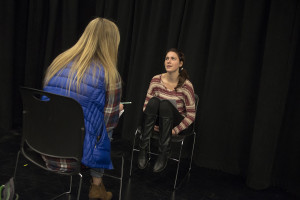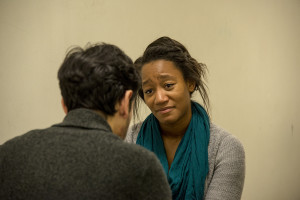Around the University Center for the Arts, the opportunity for collaboration between the visual and performing arts disciplines is plentiful. However, toward the end of last semester, a new type of cross-campus partnership formed when Shari Simmons’ individual therapy class teamed up with Amy Scholl’s acting class.
Simmons, who is an instructor and a licensed clinical social worker, thought social work majors could benefit from a mock client/therapist counseling session. Using trauma scenarios developed by the therapy class, the acting students would improvise the role of the clients. The trauma profiles used in the exercise ranged from a soldier returning from Iraq and experiencing depression and anxiety to a 40-year-old with a history of abuse to a recently sober woman who risks losing custody of her children.
Scholl was quick to offer her class for the project.
“Having participated as an actor myself years ago, both as a witness in mock trials for law students and as a patient for psychologists in training, I knew it could be of value for my students,” she explained.
Mutually beneficial
Simmons, who has had students participate in this type of activity before, said, “I know this is a little outside of the box, but my thought was it would be something to help both sets of students practice the skills we are trying to teach them.”
Previous instruction had the theatre class well-prepared for the exercise; class time spent on empathetic improv enabled them to discover and create their character’s voice.
“I always tell them it is their job to come to their character’s defense and to remember that even characters in scripted plays are ‘real’ people who often have life or death stakes at hand, if not literally, then emotionally,” explained Scholl. “Theatre in general is usually not about an average day with healthy people.”
 Additionally, both Simmons and her class thoroughly analyzed and vetted each trauma scenario, which were then sent to the acting students. In an effort to create more realistic dynamics, the therapists only found out upon arriving at the University Center for the Arts that they would be paired with students not representing the scenario they personally created.
Additionally, both Simmons and her class thoroughly analyzed and vetted each trauma scenario, which were then sent to the acting students. In an effort to create more realistic dynamics, the therapists only found out upon arriving at the University Center for the Arts that they would be paired with students not representing the scenario they personally created.
Emotional intensity
Social work major Natalie Prewitt-Parks and theatre student Mason Weiss sat on the floor along a quiet stretch of hallway working through their situation. Natalie’s sincerity and Mason’s tears symbolized the intense compassion and understanding of the moment.
“We might not have needed a script because of the natural flow,” Natalie said afterwards. “It was a safe and comforting environment. It was a good vibe.”
Mason explained that in preparing for his role as the client, he didn’t get caught up in the details.
“I tried to not over-anticipate, because that would have felt fake,” he said. “It was so organic. It felt uncomfortable in a very real way, which was good. I cried because I was able to harness it.” 
Throughout her acting class, Scholl emphasizes knowing when to “play it, not say it,” or acknowledging when physical cues are as important as words in getting a read on someone.
“I often talk to them about behavioral choices that make a character come to life off the page,” Scholl said after the activity. “I think it is the ability to communicate with body language and eye contact, or lack thereof, that the social work students found particularly helpful.”
‘A struggle at first’
Theatre student Kayla Ibarra and social work student Kara Sullivan also experienced a genuine session.
“It was a struggle at first,” said Kara, “but we finally really connected when I said I’d advocate for her.”
Kayla, who spent the entire session with very closed body language, her head buried in her chest, was visibly upset and crying.
“Even after we stopped, I really wanted to make sure that Kayla was OK,” Kara said.
Scholl often asks her students whether the audience would still have a clear idea of what is going on if the volume were turned down during their scene. It seems the students successfully internalized their training, and social work student Alicia Camuto recognized it.
“It felt like real life,” she said. “The non-verbal cues of the actor were great.”
Scholl’s students were impressed with how well the social work students listened, responded and supported them in their trial sessions.
“They made us feel comfortable, asked good questions and we would definitely want to see them for another session,” Scholl said of the general consensus.
Both instructors were also satisfied with the sessions.
“It gave both parties a chance to practice something they want to do more of in their futures,” Simmons said.